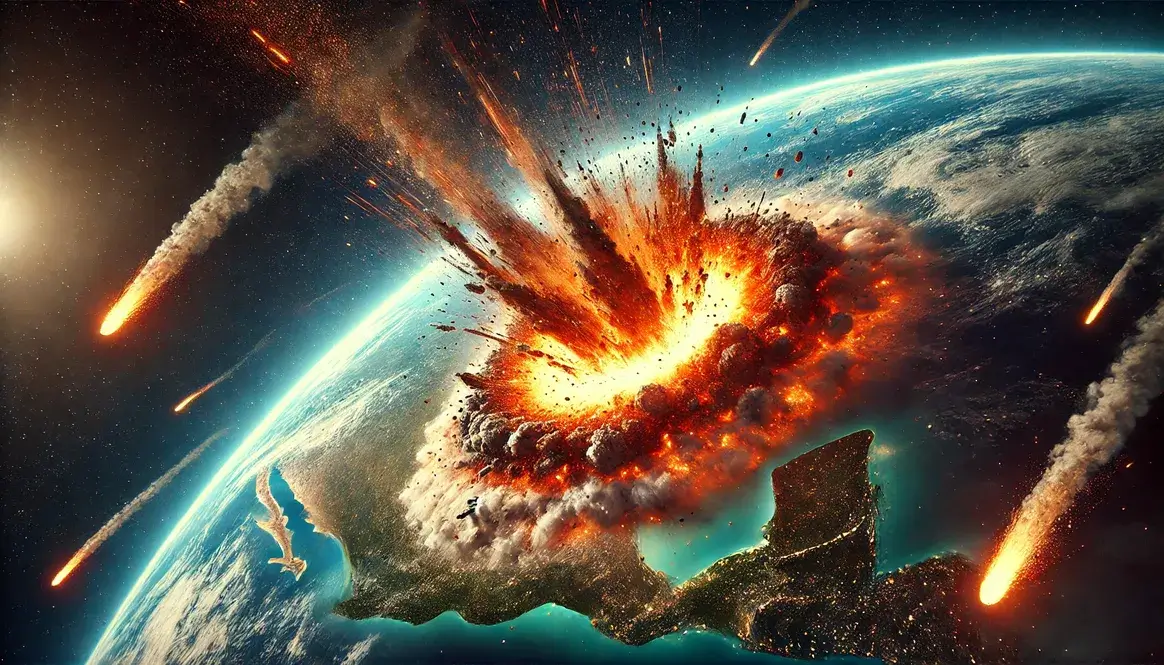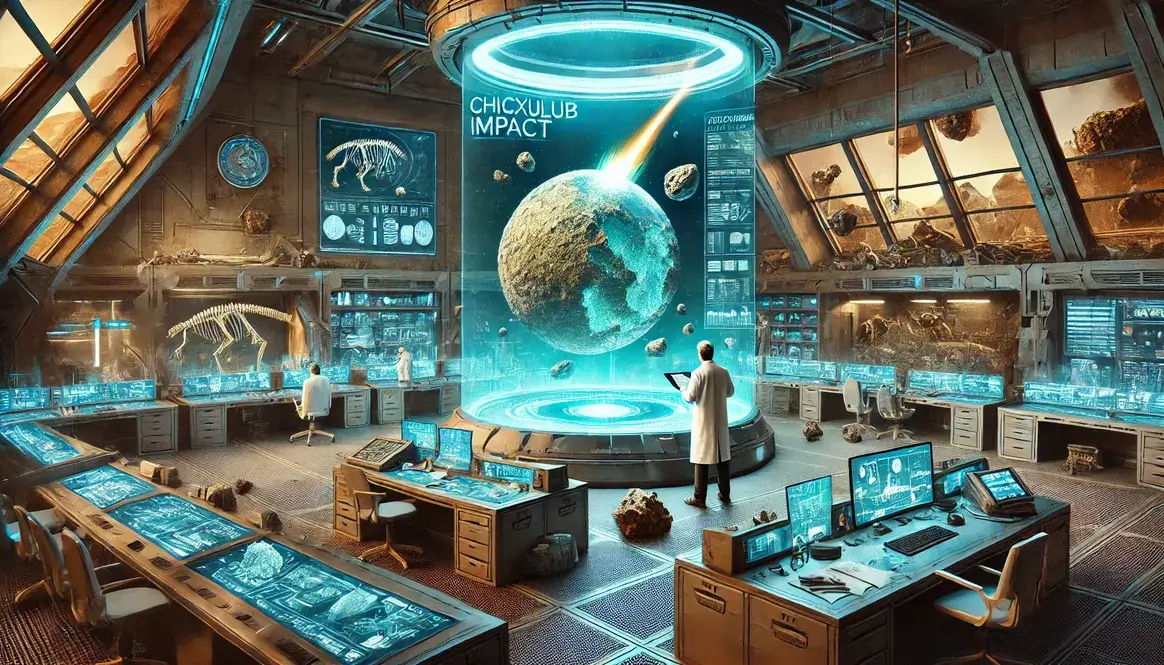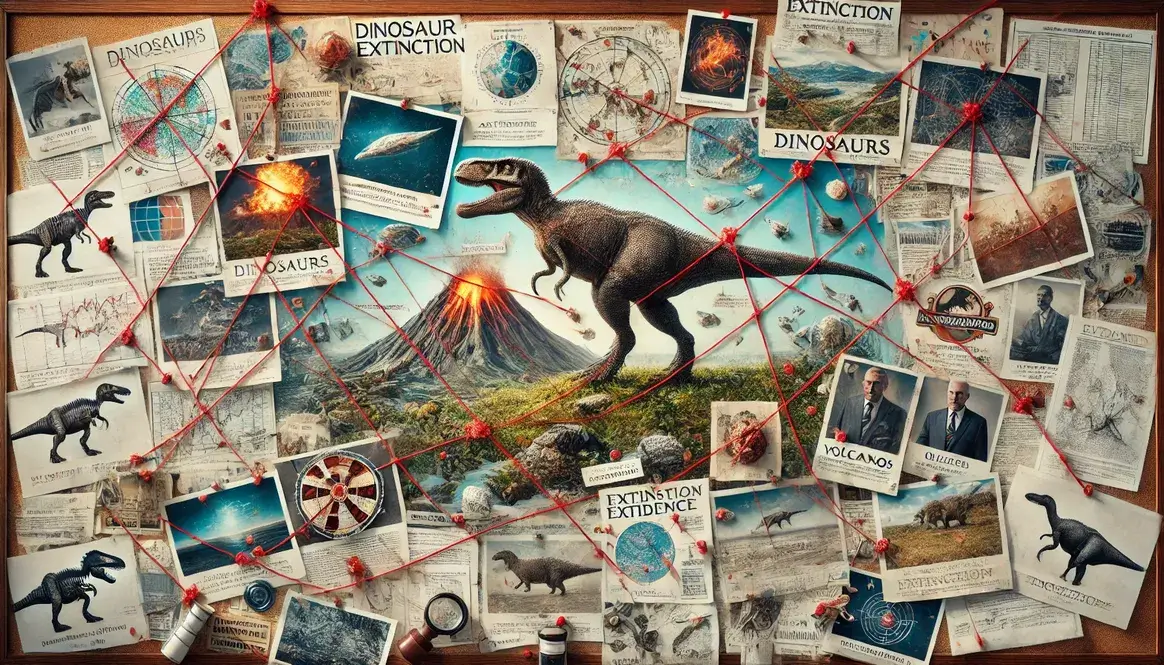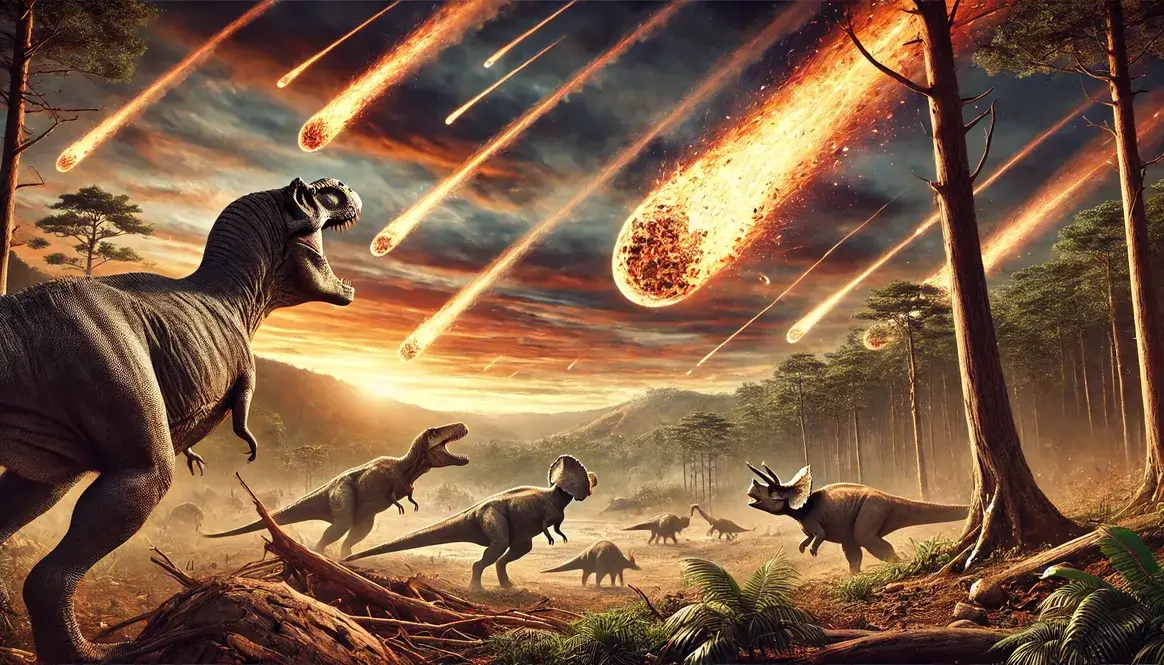The K-Pg asteroid, which played a big role in the dinosaur extinction, hit Earth about 66 million years ago. It crashed into what’s now the Yucatan Peninsula in Mexico, forming the massive Chicxulub crater.
This huge dent in Earth’s surface is about 180 kilometers (112 miles) wide and 20 kilometers (12 miles) deep. That’s as big as some small countries! The crater got its name from a nearby town called Chicxulub.
| Key Facts About the K-Pg Asteroid Impact |
|---|
| Location: Yucatan Peninsula, Mexico |
| Crater Name: Chicxulub |
| Crater Size: ~180 km (112 miles) wide |
| Impact Age: ~66 million years ago |
| Significance: Linked to dinosaur extinction |
When scientists first found clues about this impact, they didn’t know exactly where it happened. But after years of searching and studying, they figured out that the Chicxulub crater was the smoking gun they were looking for.
The asteroid that made this crater was probably about 10 to 15 kilometers (6 to 9 miles) wide. That’s like a mountain falling from space! When it hit, it caused huge changes all over the world. These changes had a big effect on the climate and many animals, including the dinosaurs.
The Chicxulub crater is special because it’s one of the best-preserved impact craters on Earth. It’s like a time capsule that helps scientists understand what happened when the asteroid hit and how it affected life on our planet.
Where Did the K-Pg Asteroid Hit? Location of the Chicxulub Crater
The Chicxulub crater isn’t just any old hole in the ground. It’s a massive scar on Earth’s surface that tells a story of an event that changed our planet forever. Let’s explore where exactly this incredible crater is located.
Geographic coordinates
If you’re into maps and coordinates, you’ll find the center of the Chicxulub crater at:
- Latitude: 21.4° N
- Longitude: 89.5° W
These numbers might seem like just a bunch of digits, but they mark the spot where a space rock as big as a mountain slammed into Earth.
Present-day location on the Yucatan Peninsula
Today, if you want to visit the site of this ancient cosmic collision, you’d need to head to Mexico’s Yucatan Peninsula. The crater is mostly buried under layers of rock and sediment, but its rim peeks out along the coastline.
Here are some fun facts about the crater’s location:
- Half of it is underwater in the Gulf of Mexico
- The other half is on land, under the Yucatan Peninsula
- The towns of Puerto Chicxulub and Merida sit near the crater’s center
- You can’t see the whole crater from the ground – it’s too big!
Size and shape of the crater
The Chicxulub crater is truly enormous. Its size and shape tell us a lot about the powerful impact that formed it.
| Crater Feature | Measurement |
|---|---|
| Diameter | ~180 km (112 miles) |
| Depth | ~20 km (12 miles) |
| Shape | Multi-ring basin |
The crater isn’t just a simple bowl shape. It’s what scientists call a “multi-ring basin.” This means it has several circular rings of hills and valleys, like ripples in a pond when you throw in a stone. These rings formed because of the way the Earth’s crust bounced back after the impact.
The size of the Chicxulub crater helps scientists figure out how big the asteroid was and how much energy it released when it hit. This information is crucial for understanding the global effects of the impact, including massive tsunamis, worldwide wildfires, and the climate changes that followed.
Significance of the Impact Location
The Chicxulub crater’s location wasn’t just bad luck for the dinosaurs – it played a crucial role in making this impact so devastating. Let’s dig into why this spot was so important.
Geological composition of the impact area
When the asteroid hit, it didn’t just crash into any old rock. The Yucatan Peninsula had a special geological makeup that made the impact even worse:
- Limestone-rich crust
- Lots of sulfur-containing minerals
- Shallow sea covering the area
This combination was like lighting a match in a room full of fireworks. When the asteroid hit, it vaporized these rocks, releasing a cocktail of gases into the atmosphere. The limestone created huge amounts of carbon dioxide, while the sulfur formed sulfuric acid aerosols. Talk about a recipe for disaster!
Effects on global climate and environment
The impact’s location had far-reaching consequences for Earth’s climate and environment:
- Global cooling: The sulfur aerosols reflected sunlight back into space, causing a rapid cooling effect. This led to what scientists call an impact winter, where temperatures dropped dramatically worldwide.
- Acid rain: The sulfuric acid in the atmosphere came back down as acid rain, damaging plants and acidifying oceans.
- Wildfires: The impact caused widespread fires that burned across much of the planet, adding more smoke and soot to the already darkened skies.
- Mega-tsunamis: The shallow sea at the impact site led to massive tsunamis that reshaped coastlines around the Gulf of Mexico and beyond.
Role in dinosaur extinction
The unique location of the Chicxulub impact played a starring role in the dinosaurs’ final act. Here’s how:
- Rapid climate change: The sudden shift from a warm Cretaceous world to a dark, cold one was too much for many species to handle.
- Food chain collapse: With plants struggling in the new climate, herbivores had little to eat. This ripple effect moved up the food chain, affecting carnivores like T. rex.
- Long-lasting effects: The environmental changes lasted long enough to prevent many species from bouncing back, leading to their eventual extinction.
The Chicxulub impact wasn’t just a local catastrophe – its effects rippled across the entire planet. The unlucky location amplified these effects, turning a bad day for dinosaurs into their last day on Earth. This event marked the end of the Cretaceous period and paved the way for the rise of mammals, eventually leading to us!
Discovering the Chicxulub Crater
Finding a giant crater isn’t as easy as you might think, especially when it’s mostly hidden underground and under the sea. The story of how scientists discovered the Chicxulub crater is like a real-life detective mystery. Let’s uncover how they pieced together the clues!
Initial clues and theories
The hunt for the impact site began long before anyone knew about Chicxulub. Here’s how it started:
- In 1980, a team led by Luis Alvarez found high levels of iridium in rock layers from the end of the Cretaceous period.
- Iridium is rare on Earth but common in asteroids, leading to the Alvarez asteroid theory.
- Scientists began searching for a crater big enough to match the global iridium layer.
At first, they looked all over the world, from the Pacific Ocean to Eastern Europe. But the real culprit was hiding in plain sight in Mexico!
Geological surveys and evidence
As the search continued, more pieces of the puzzle fell into place:
- Gravity measurements: In the late 1970s, geophysicists noticed something odd in gravity readings from the Yucatan. There was a big, circular anomaly that didn’t match the surrounding area.
- Magnetic data: Surveys also showed a large, circular magnetic anomaly in the same spot.
- Rock samples: Oil companies drilling in the area found strange rocks that looked like they had been melted and re-formed.
These clues were interesting, but scientists needed more evidence to be sure they had found the impact site.
Confirming the crater’s existence
The final pieces of evidence that confirmed the Chicxulub crater’s existence came from a combination of careful study and a bit of luck:
- Shocked quartz: Geologists found tiny grains of quartz with special fractures that only form under extreme pressure, like from an asteroid impact.
- Tektites: Small, glass-like objects formed from rock melted by the impact were discovered in Haiti, linking the Caribbean region to the event.
- Core samples: In 1991, scientists drilled into the crater and found rock layers that matched what they expected from a massive impact.
With all this evidence, the scientific community became convinced that Chicxulub was indeed the long-sought impact crater. This discovery was a huge breakthrough in understanding what happened to the dinosaurs and how one event could change life on Earth so dramatically.
The Chicxulub crater’s discovery shows how science works – it’s not always about sudden “Eureka!” moments, but often a slow gathering of evidence until the truth becomes clear. In this case, that truth was hiding under millions of years of rock and seawater, waiting to tell its story.
Geological Features of the Impact Area
The Chicxulub crater is like a giant history book written in rock. Its geological features tell the story of that fateful day when an asteroid changed Earth forever. Let’s explore the fascinating details scientists have uncovered about this incredible impact site.
Crater structure and layers
The Chicxulub crater isn’t just a simple bowl-shaped hole. Its structure is complex and full of interesting features:
- Central peak ring: In the middle of the crater, there’s a ring of mountains. These formed when the center of the crater bounced back up after the impact, like a drop of water splashing.
- Crater rim: The outer edge of the crater is marked by a raised rim, which helps scientists determine the crater’s size.
- Layers of debris: Inside the crater, there are layers of rock that tell the story of the impact:
- Bottom layer: Melted and shocked rocks from the initial impact
- Middle layer: Bits of rock that fell back into the crater after being thrown into the air
- Top layer: Sediments that slowly filled the crater over millions of years
Scientists have used advanced impact simulations to understand how these features formed in the seconds and minutes after the asteroid hit.
Presence of impact-related minerals
The extreme heat and pressure of the impact created some unique minerals that you don’t find in normal rocks. These special minerals are like fingerprints left behind by the asteroid:
- Shocked quartz: Normal quartz grains that have special fractures from the intense pressure of the impact
- Tektites: Small, glass-like objects formed from rock that was melted and thrown into the air
- Nanodiamonds: Tiny diamonds created by the extreme pressure of the impact
These minerals are important because they help scientists confirm that this was definitely an impact crater and not some other geological feature.
Changes in local rock formations
The asteroid impact didn’t just create a crater – it completely changed the local geology. Here’s how:
- Fractured bedrock: The force of the impact cracked and shattered the surrounding rock for miles around.
- Uplifted rock layers: Some deep rock layers were pushed up to the surface, giving scientists a peek at rocks that are usually buried deep underground.
- Altered chemical composition: The extreme heat changed the chemical makeup of the local rocks, creating new minerals and altering existing ones.
These changes in the rock formations have had lasting effects on the Yucatan Peninsula. For example, they influence how water flows underground, creating the region’s famous cenotes (natural sinkholes filled with groundwater).
The geological features of the Chicxulub crater are a testament to the incredible power of the impact. They show us that even though the asteroid hit millions of years ago, its effects are still visible in the rocks beneath our feet. Studying these features helps scientists understand not just what happened when the asteroid hit, but also how such impacts might affect our planet in the future.
Impact on the Yucatan Peninsula
The Chicxulub impact didn’t just affect the dinosaurs – it completely transformed the Yucatan Peninsula. Let’s explore how this cosmic collision reshaped the local landscape, both immediately and in the long run.
Immediate effects on the local area
When the asteroid hit, the Yucatan Peninsula experienced destruction on an unimaginable scale. The impact released energy equivalent to billions of atomic bombs, causing:
- Instant vaporization of the asteroid and surrounding rock
- A fireball that expanded outward, incinerating everything in its path
- Massive earthquakes that shook the entire region
The shallow sea covering the area was blown away, exposing the seafloor. Then, as the crater collapsed, enormous tsunamis raced outward, flooding coastal areas for hundreds of miles around. The local ecosystem was completely obliterated in a matter of minutes.
Long-term changes to the landscape
After the initial devastation, the Yucatan Peninsula continued to change:
- Crater formation: As the dust settled, a massive crater over 110 miles wide remained, forever altering the peninsula’s shape.
- Climate shifts: The impact threw so much dust and sulfur into the atmosphere that it caused years of global cooling. The Yucatan, once a tropical paradise, likely experienced much colder temperatures.
- New water systems: The fractured bedrock created a unique groundwater system. Over time, this led to the formation of cenotes – natural sinkholes filled with freshwater that are characteristic of the Yucatan today.
- Altered plant and animal life: As life slowly returned to the area, new species evolved to fill the ecological niches left by extinct organisms.
These changes didn’t happen overnight. It took thousands of years for the Yucatan to transform into the landscape we see today.
Modern-day remnants of the impact
Even after 66 million years, signs of the Chicxulub impact are still visible in the Yucatan Peninsula:
The most obvious remnant is the crater itself. While mostly buried, its rim forms a semicircle of sinkholes (cenotes) visible from space. These cenotes are now popular tourist attractions and were sacred to the ancient Maya people.
Geologists have also found shocked quartz and other impact-related minerals in rock layers throughout the region. These tiny fragments are like time capsules, preserving evidence of that cataclysmic day.
Perhaps most interestingly, the impact’s legacy lives on in the peninsula’s unique ecosystem. The region’s distinctive soil composition and water systems, shaped by the crater, support a diverse array of plant and animal life found nowhere else on Earth.
The Chicxulub impact didn’t just change the Yucatan Peninsula – it created it as we know it today. From its underground rivers to its lush jungles, much of what makes this region special can be traced back to that fateful day 66 million years ago when an asteroid changed the course of Earth’s history.
Global Consequences of the Impact Location
The Chicxulub impact was far more than just a local catastrophe. Its effects rippled across the entire planet, reshaping Earth’s climate and ecosystems. Let’s explore how this single event in Mexico had worldwide consequences.
Spread of debris and dust
When the asteroid slammed into the Yucatan Peninsula, it didn’t just create a crater. It launched an enormous plume of debris into the atmosphere. This wasn’t your average dust cloud – it was a mix of pulverized rock, vaporized asteroid, and Earth materials.
Within hours, this debris began to spread around the globe:
- Larger chunks fell back to Earth as fiery rain, igniting wildfires across continents
- Finer particles stayed suspended in the upper atmosphere for months or even years
- A layer of iridium-rich dust eventually settled worldwide, forming what geologists call the K-Pg boundary layer
This global blanket of debris had far-reaching effects on Earth’s climate and life forms.
Worldwide climate effects
The impact location played a crucial role in the global climate changes that followed. The sulfur-rich rocks of the Yucatan Peninsula released massive amounts of sulfur dioxide into the atmosphere when vaporized by the impact. This led to a series of dramatic climate shifts:
- Global cooling: The sulfur aerosols reflected sunlight back into space, causing a rapid drop in global temperatures. This “impact winter” likely lasted for years.
- Acid rain: As the sulfur dioxide mixed with water in the atmosphere, it created acid rain that fell worldwide, damaging plants and acidifying bodies of water.
- Darkness: The thick dust and aerosol cloud blocked out sunlight, plunging much of the Earth into darkness for months. This severely impacted photosynthesis and disrupted food chains.
These climate effects were particularly severe because of the impact’s location. If the asteroid had hit a different part of the Earth with less sulfur-rich rocks, the aftermath might have been less catastrophic.
Impact on marine and terrestrial life
The global consequences of the Chicxulub impact were devastating for life on Earth:
Marine ecosystems: The oceans bore the brunt of the impact’s effects. Acid rain and runoff from land acidified the upper layers of the oceans, making life difficult for many marine organisms. The lack of sunlight also disrupted the food chain, starting with plankton and working its way up to larger creatures.
Terrestrial life: On land, the effects were equally severe. Many plant-eating dinosaurs struggled to find food as plants died off due to lack of sunlight and acid rain. This, in turn, affected the carnivorous dinosaurs that preyed on them.
The impact’s global reach meant that few places on Earth were safe. Even areas far from the impact site experienced dramatic changes in temperature, rainfall, and food availability. This worldwide disruption led to one of the largest mass extinctions in Earth’s history, paving the way for the rise of mammals and eventually, humans.
The Chicxulub impact shows us how interconnected our planet’s systems are. A single event in one location can have consequences that span the globe and echo through millions of years of history.









